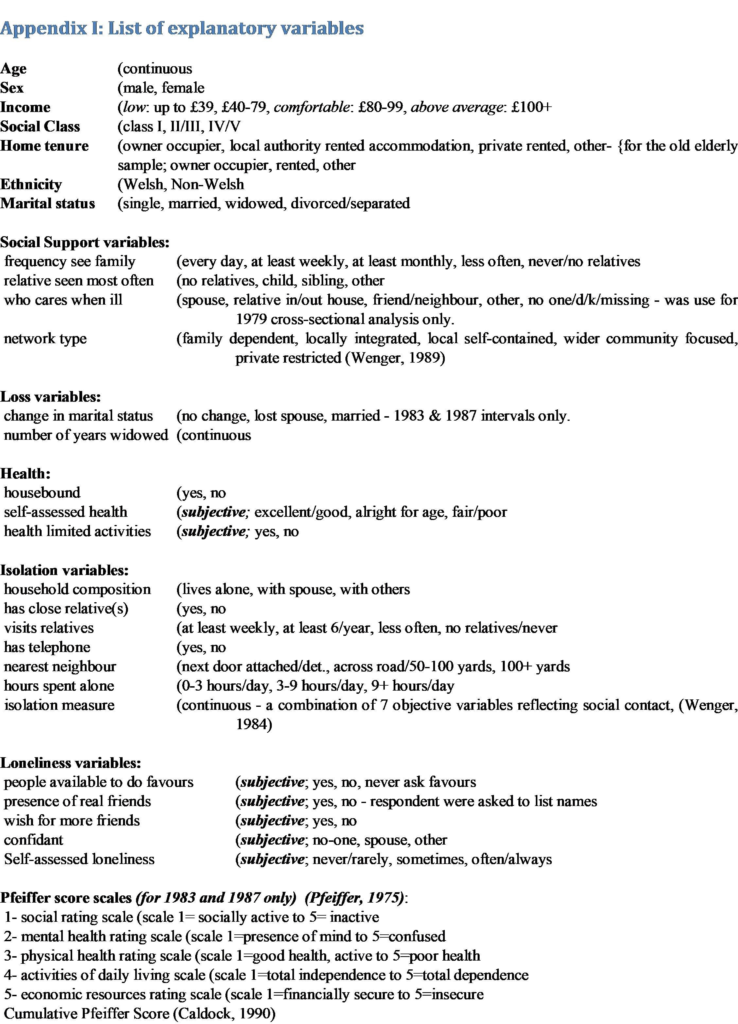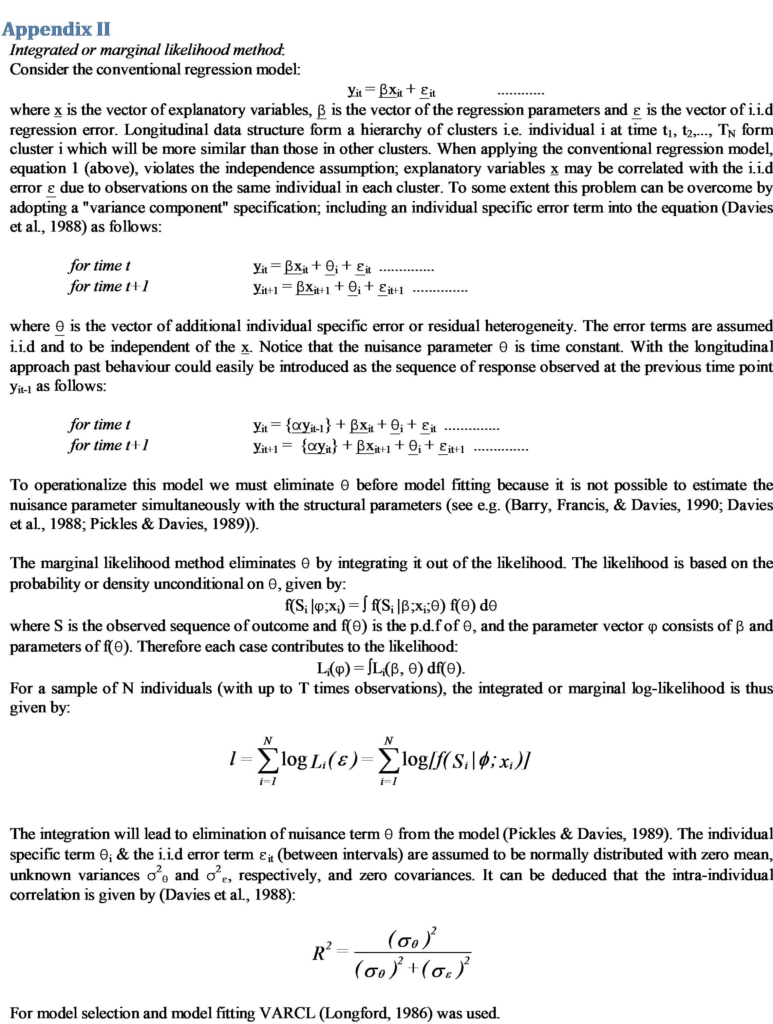A longitudinal analysis of morale in old age
Said Shahtahmasebi, PhD
The Good Life Research Centre Trust, Christchurch, New Zealand.
Correspondence: radisolevoo@gmail.com
Key Words: heterogeneity, past behaviour, depression, quality of life Received: 9/7/2020; Revised: 10/8/2020; Accepted: 28/8/2020
[citation: Shahtahmasebi, Said. (2020). A longitudinal analysis of morale in old age. DHH, 7(3):http://www.journalofhealth.co.nz/?page_id=2239].
Abstract
This paper examines recurrent continuous morale in old age within a statistical modelling paradigm. In order to assess the degree to which explanatory variables influence morale, an adequate statistical model must handle the possibility that substantial variation between respondents will be due to unmeasured and potentially unmeasurable variables (residual heterogeneity), multicollinearity and past behaviour effect. These applications are illustrated using morale in old age from the North Wales Longitudinal Study Old Age. The results suggested a strong presence of heterogeneity effect, i.e. current levels of morale appear to be individual-specific and independent of its previous levels.
INTRODUCTION
There may be a true underlying relationship between morale and variables reported in the literature, however, there is a lack of clarity as to how these variables interact over time and whatever impact they have on morale.
One of the fundamental methodological problems, quite apart from the issues of defining and measuring quality of life, is disentangling the complex inter-relationships between quality of life and other variables. In reviewing the literature, Wenger (Wenger, 1992) emphasized the difficulties inherent in attempting to disentangle the relationships of interest. As with any research based on survey data, it is difficult to distinguish systematic from the random patterns due to other variables. The flexibility of survey/observational studies to measure a wide range of subjective and objective variables adds complexities to analyses. Survey studies of elderly people living in the community do not often include measures of depression, morale or dementia all at the same time. In this context, quite apart from the methodological issues of multicollinearity and the direction of causality, the issue of bias in the sample due to unmeasured or omitted variables needs also to be addressed. Wenger et al (Wenger, Davies, & Shahtahmasebi, 1995) have addressed some of the difficulties associated with the analysis of survey data and reported an improved cross-sectional multivariate analysis to incorporate two fundamental issues of multicollinearity and the direction of causality. However, cross-sectional analysis does not allow an assessment of past behaviour (e.g. state dependence) and do not handle heterogeneity effect due to omitted variables (e.g. frailty).
Heterogeneity results when systematic but unmeasured characteristics of individuals contribute to response pattern over time. In survey studies some individual characteristics are often omitted from the study either because they are unobserved or difficult to measure. Omitted characteristics such as frailty, could lead to spurious relationships between the observed characteristics and the outcome variable. Past behaviour effect exists when the experience of a particular outcome itself changes the probability of experiencing that event on subsequent occasions. Again, it is clear that past behaviour cannot be addressed within cross-sectional designs. Heterogeneity and past behaviour effects are common, when dealing with behavioural data and ignoring them will produce bias in variability estimates and tests of treatment related hypothesis (Davies, 1987; Gibbons, et al. 1993).
Longitudinal studies provide an additional flexibility to increase control in the analysis; with panel data it is possible to control for heterogeneity, temporal dependencies and to get a better understanding of the direction of causality (Davies, 1987, 1994). However, the traditional methods of analysing longitudinal data such as analysis of end points and analysis of variance do not fully utilise the properties of the data, in particular, such methods exclude the heterogeneity effect (Everitt, 1998; Gibbons et al., 1993). Increasing number of methods are available to improve cross-sectional studies. While, these methods tend to reduce the number of variables to focus on, they can raise other complex questions about the nature of the process over time. Such outcomes are, in their own right, an important aspect of the results.
A review of the literature on morale in old age is not attempted, the interested reader is referred to (Landeiro, et al. 2017; Schoene et al., 2019; Wenger, 1992; Wenger et al., 1995). In this paper a method of analysing longitudinal data is demonstrated, which allows for heterogeneity simultaneously with multicollinearity and past behaviour effects. For comparison purposes a cross-sectional analysis of the same data is also presented. These applications are illustrated using repeated observations on morale in old age.
METHODS
The data come from a survey of elderly people living in rural North Wales (Wenger et al., 1995). The data structure is shown in Table 1(a). As it can be seen, three time data were available only for the old elderly (75+). Furthermore, a variable of interest, the Pfeiffer dependency scores, was included in the questionnaire in 1983 and 1987 interval points. These scores are interviewers’ observed health and dependency using five scales (see appendix I), which may be seen as more objective than self-assessed state of health and other self-reported dependencies. Therefore, it was decided to restrict the analysis to the 1983 and 1987 time points. This strategy also allows the flexibility to test the past behaviour effect using data from 1979.
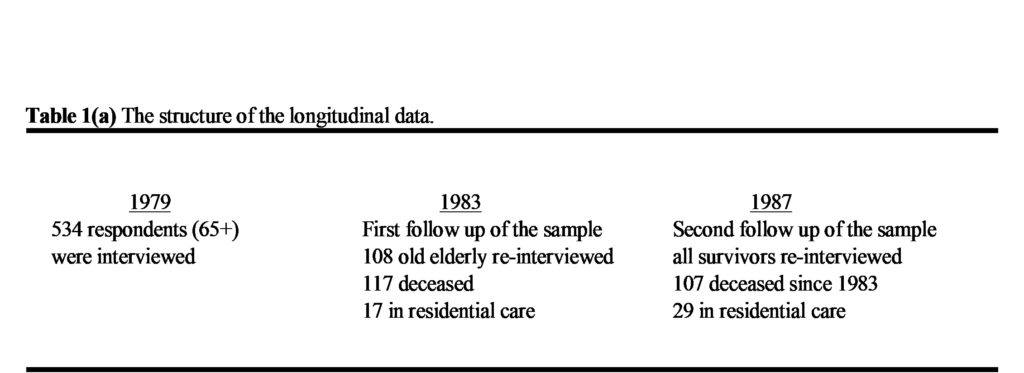
Morale scale
The Philadelphia Geriatric Centre Morale Scale (Lawton, 1975) was Anglicised and adapted (see Table 1b) as part of a major study of old age in rural North Wales (Wenger, 1984; Wenger et al., 1995). High morale item responses were therefore scored as 3 and low morale responses as 1. Those whose morale was insufficiently high or low to give an unequivocal response scored 2 as an intermediate measure as shown in the table. Aggregate morale was then calculated as an average of the 17 responses. This aggregate measure formed continuum from 1.0 (low morale) to 3.0 (high morale).
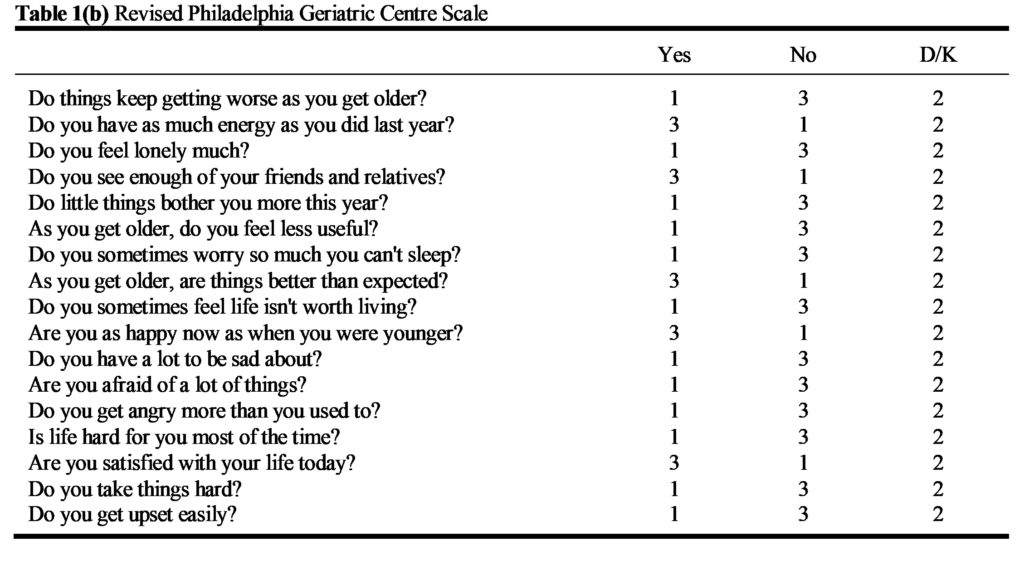
There were 38 cases with a valid morale score at each interval point 1983 and 1987 in the North Wales Elderly Data. The sample size appear small, however, Table 1(c) suggests that it is sufficiently large to detect a small difference of 0.1 on the morale scale with 5% and 20% probability of type I and type II error (power of 80%) respectively (Diggle, et al. 1994). Because of the relatively small sample size large categorical variables were collapsed into 2 or three categorical variables. The list of explanatory variables is shown in the appendix I.
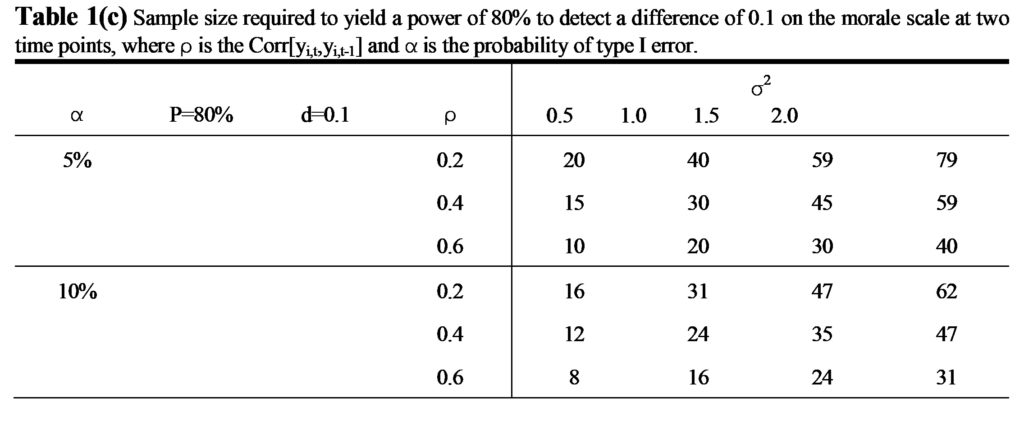
Models for analysis
A regression type model was specified with morale as the response variable. The advantages of a regression model over other methods, such as analysis of variance or end-point, are the ability to handle heterogeneity as well as a large number of continuous and categorical explanatory variables, provide an estimate of the difference in the pattern of response given an explanatory variable, and, allow to estimate not only the main effect of explanatory variables but also first and higher order interactions between them.
For the longitudinal analysis of morale the 1983 and 1987 data points were used, thus forming a sequence of observations on the same individuals. Fitting the conventional regression model to such data lead to a well-known specification error. The regression model was modified with a “variance component” specification in which the heterogeneity effect is implicitly defined in the equation as a time constant term {θ} separately from the regression error term {ε} (Davies, et al. 1988) (see appendix II). There are two methods of model estimation for models with two unobserved components; the conditional likelihood method and the marginal likelihood method. The conditional likelihood method, sometimes referred to as the difference method, eliminates θ by subtracting the response equation for time 2 from that of time 1. This differencing leads to the term θ and all other constant variables (such as sex) to be eliminated from the model, thus, restricting inference to time varying variables. The resulting model could then be fitted using the likelihood or least squares method (Anderson & Hsiao, 1981; Chamberlain, 1980; Shahtahmasebi, 1995). A drawback of this method is the loss of information. However, the method is easy to adopt and apply in particular when dealing with continuous response variable measured at two time points. Furthermore, loss of information can be compensated for by integrating the instrumental variables method in the statistical modelling (Shahtahmasebi, 2014).
In this paper the marginal likelihood method was used. This method, also referred to as the integrated likelihood method, eliminates θ by integrating it out of the likelihood equation (Davies et al., 1988; Pickles & Davies, 1989). This method allows time varying and time constant variables in the analysis. Notice that the independence assumption, that the error terms are independent of the included explanatory variables, must still hold. This method provides a useful statistic for the heterogeneity effect which is given by the within-individual correlation (R2)(see appendix II).
The computer program VARCL (Longford, 1986) which handles variance component models with a continuous response variable, was used for model fitting. Variables were tested in the model one at a time using the likelihood ratio (χ2) and the F-ratio goodness of fit test, for the longitudinal and the pooled cross-sectional methods, respectively. The variable with the largest χ2 and associated smallest p-value was entered into the model next. The process was repeated with those variables, which were significant at 10% level, until there were no statistically significant variables remaining.
For comparison purposes a cross-sectional analysis of the same data was also carried out. The standard regression model without structural modification was fitted to the data. Thus, the cross-sectional model assumes that the observations on the same individuals in 1983 are independent of the 1987 i.e. giving a total sample of (2×38) 76 cases.
Some authors have suggested that subjective variables may play an intervening role between objective variables and morale (Wenger, 1992). Variables were classified as subjective if they were subject to the respondent’s interpretation (Wenger et al., 1995), see appendix I. Through their possible relationship with the omitted variables, the subjective variables are responsible for model mis-specification and erroneous results.
RESULTS AND DISCUSSION
Past behaviour effect was tested within the modelling framework using dummy variables representing morale in 1979 and 1983 in the longitudinal analyses. For this data set past levels of morale do not appear to be correlated with the present levels of morale. The results from the different methods are summarised in Table 2 & 3.
Cross-sectional method suffers from a lack of clarity due to a marginal choice between the variables “confidant” (p=0.003) and “Pfeiffer mental rating” (p=0.02) (one is a more limited and subjective manifestation of the other), “confidant” is selected to be included in the final model. The fitting process for the longitudinal model clearly reveals that including the cumulative rating in the model removes the high significance of both physical and mental rating i.e cumulative Pfeiffer dependency appears to control for the effect of both physical and mental ratings.
The results from the cross-sectional method suggest that dependency due to physical health (as measured by the Pfeiffer Scale) may lead to lower levels of morale; on average, those highly dependent individuals as shown by the physical dependency scale score lower on the morale scale. Perception of having a “confidant” appears to be positively correlated with morale; availability of “confidant” increases levels of morale as opposed to not having a “confidant” at all. It is plausible that perceived companionship in old age as reflected by “confidant” operates in the opposite direction of the effects from any lack of quality of life associated with lowered mental competence that may be affecting morale.
The results from the marginal likelihood method, allowing control for heterogeneity effect, seem to suggest no direct link between subjective variables and morale for this data set. The objective variable “cumulative Pfeiffer” dependency measure appears to control for the effect of all the other variables. The high within-individual correlation (R2=0.66 Table 3) emphasizes the importance of adopting a methodology, which allows control for heterogeneity effect. The results from this model suggest that those with higher physical health dependency, as measured by the cumulative Pfeiffer score, on average, score 0.25 (5*-0.05) lower on the morale scale (other characteristics being the same). The within-individual correlation of (R2=0.66) confirms the substantial heterogeneity effect in the data which means that temporal dependencies of morale in old age is due to heterogeneity rather than previous state of morale i.e. those who currently appear to be of low morale are inherently so. This result highlights the important role of panel data and methodologies that allow control for this effect.
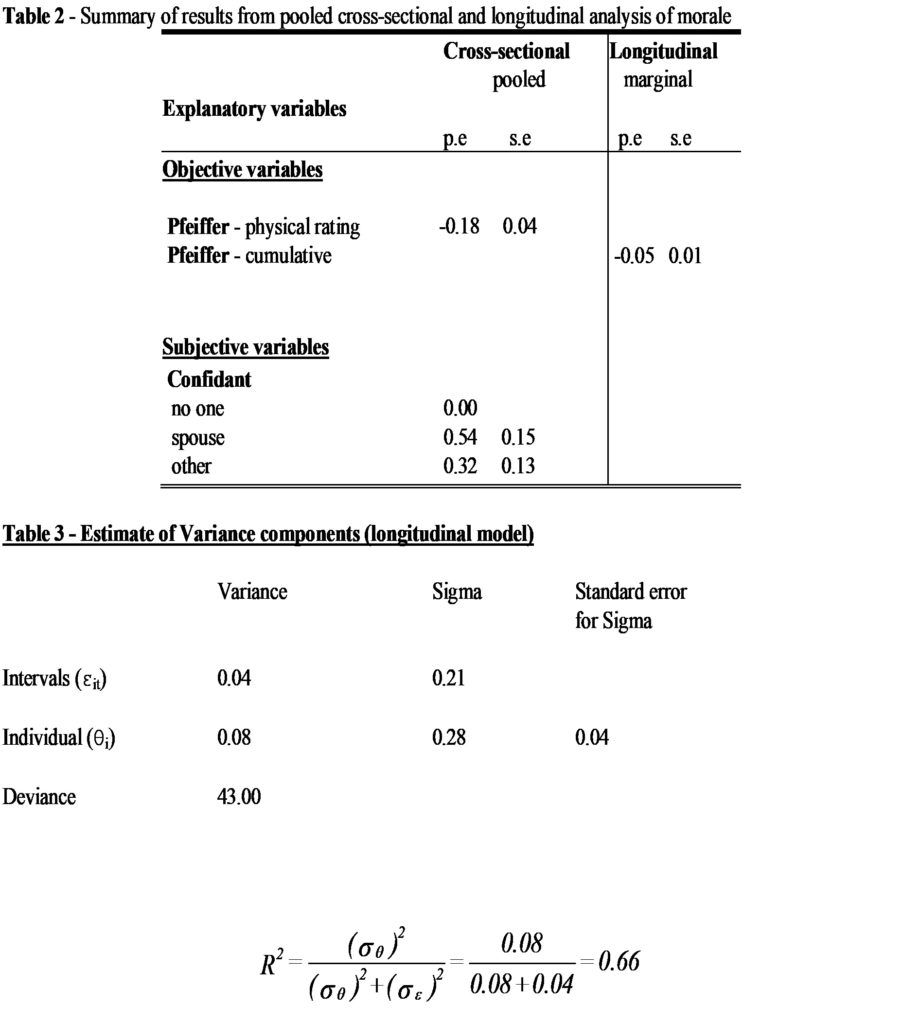
CONCLUSION
It is reassuring to note that, given the size of the sample, the results appear robust which is indicated by the small parameter estimates and their standard errors. Furthermore, the model fitting approach of excluding and including subjective variables ensured the identification of the weaker effects in the data, as well as, providing an idea about the role of subjective variables which is confirmed by the longitudinal modelling. On the whole, there were fewer variables to focus on than reported in the literature.
The concepts and approach presented in this paper have clear implications for “evidence-based” health and social policy development and evaluation. It is, clearly, important to employ panel data and methodologies, which handle the heterogeneity effect. On the other hand, ignoring heterogeneity effect in the analysis may lead to spurious relationships and an over estimation of the effect of included explanatory variables, also see (Shahtahmasebi, 2018). For example, while age and state of health may appear to be significantly related to morale in old age, such relationships may well be due to a correlation between age, health with depression and frailty, which are omitted from the study.
REFERENCES
Anderson, T. W., & Hsiao, C. (1981). Estimation of dynamic models with error components. American Statistics Association, 76(375).
Barry, J., Francis, B., & Davies, R. (1990). Software for Analysis of Binary Recurrent Events (SABRE): A guide for users. Lancaster: Centre for Applied Statistics, Lancaster University.
Caldock, K. (1990). Domiciliary Services and dependency A Meaningful relationship? : CSPRD, University of Wales, Bangor.
Chamberlain, G. (1980). Analysis of Covariance with Qualitative Data Review of Economic Studies. XLVII, 225-238.
Davies, R. (1987). The limitation of cross-sectional analysis. In R. Crouchley (Ed.), Longitudinal Data Analysis. London: Sage.
Davies, R. (1994). From cross-sectional to longitudinal analysis. In A. Dale & R. B. Davies (Eds.), Analysing social and political change: A casebook of methods (pp. 20-40). London: Sage.
Davies, R., Martin, A. M., & Penn, R. (1988). Linear modelling with clustered observations an illustratative example of earnings in the engineering industry. Environment and Planning A, 20, 1069-1084.
Diggle, P. J., Liang, K.-Y., & Zeger, S. L. (1994). Analysis of longitudinal data. Oxford: Oxford University Press.
Everitt, B. S. (1998). Analysis of longitudinal data: beyond MANOVA. British Journal of Psychiatry, 172, 7-10.
Gibbons, R. D., Hedeker, D. R., Elkin, I., & Waternaux, C. (1993). Some conceptual and statistal issues in analysis of longitudinal psychiatric data: Application to the NIMH Treatment of Depression Collaborative Research Program dataset. Archives of General Psychiatry, 50(9), 739-750.
Landeiro, F., Barrows, P., Musson, E. N., Gray, A. M., & Leal, J. (2017). Reducing social isolation and loneliness in older people: a systematic review protocol. BMJ open, 7(5).
Lawton, M. P. (1975). The Philadelphia Geriatric Centre Morale Scale a revision. Journal of Gerontology, 30, 85-89.
Longford, N. T. (1986). Variance Component Analysis VARCL. Lancaster: Centre for Applied Statistics, Lancaster University.
Pfeiffer, E. (1975). The older American Resources Scale. Duke University, North Carolina, U S A.
Pickles, A., & Davies, R. (1989). Inference from cross-sectional and longitudinal data for dynamic behavioural processes. In J. Hauer (Ed.), Urban dynamics and spatial choice behaviour (pp. 81-104): Kluwer Academic.
Schoene, D., Heller, C., Aung, Y. N., Sieber, C. C., Kemmler, W., & Freiberger, E. (2019). A systematic review on the influence of fear of falling on quality of life in older people: is there a role for falls? Clinical interventions in aging, 14, 701.
Shahtahmasebi, S. (1995). Statistical modelling of dependency in old age. Ph.D, University of Wales, Bangor, North Wales.
Shahtahmasebi, S. (2014). Dealing with model mis-specification in the analysis of morale in old age Open Journal of Social Science, 2(1), 64-71. Open Access http://www.scirp.org/journal/JSS/. doi: 10.4236/jss.2014.21008
Shahtahmasebi, S. (2018). Teenage smoking: why it is important to evaluate reported evidence. Dynamics of Human Behaviour (DHH), 5(4), http://www.journalofhealth.co.nz/?page_id=1692.
Wenger, G. C. (1984). The Supportive Network – coping with old age. London: George Allen and Unwin.
Wenger, G. C. (1989). Support Networks in Old Age: Constructing a Typology. In M. Jefferys (Ed.), Growing Old in the Twentieth Century (pp. 166-185). London: Routledge.
Wenger, G. C. (1992). Morale in old age: A review of the literature. Int. J. Geriatr. Psychiat., 7, 699-708.
Wenger, G. C., Davies, R., & Shahtahmasebi, S. (1995). Morale in Old Age: Refining the Model. International Journal of Geriatric Psychiatry, 10, 933-943.
![]()
